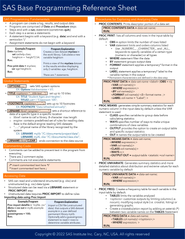- Home
- /
- SAS Communities Library
- /
- FAQ for students and independent learners
- RSS Feed
- Mark as New
- Mark as Read
- Bookmark
- Subscribe
- Printer Friendly Page
- Report Inappropriate Content
FAQ for students and independent learners
- Article History
- RSS Feed
- Mark as New
- Mark as Read
- Bookmark
- Subscribe
- Printer Friendly Page
- Report Inappropriate Content
Getting Started in Communities
 |
The SAS Support Communities are here to help!
|
- Regardless of whether you are a new SAS user or a SAS Certified Professional, try searching our archive of previously answered questions! If you can’t find what you’re looking for, you can easily post your question and receive a detailed answer from a SAS expert!
- If your questions are specific to SAS academic software, you can find everything you need in the SAS Software for Learning Community!
- If you’re taking a SAS course, take a look at our course-specific forums:
There are a few simple ways to get help:
- A keyword search on the SAS Communities homepage or even a Google search will quickly tell you whether your topic has been addressed in the SAS Support Communities. If your question is completely unique (good for you!), then you can easily post it to our forum. A dropdown menu will help you decide which forum it should go to.
Chat with a Customer Engagement Agent by clicking the gray and white chat icon in the lower-right corner of this page. It looks like this!
- You can also send an email directly to the Contact Center.
Resources for Students

- For SAS Viya for Learners:
- If you do not have an account, start here!
- Already have an account? Log in here!
- Watch this video for a step-by-step guide to getting started.
- For SAS Viya Workbench for Learners:
- If you do not have an account, start here!
- Already have an account? Log in here!
- Watch this video for a step-by-step guide to getting started.
|
Yes! SAS also provides you all the resources you need to become a savvy SAS User! Sign up with your academic email and access powerful e-learning, in-person training, and many video tutorials!
|
 Click here to download the SAS Base Programming Reference Sheet! Click here to download the SAS Base Programming Reference Sheet! |
If you’re considering a SAS Certification, you may have questions. Start here! We want your certification journey to be as smooth as possible, so we have an abundance of resources available:
- Prepare for certification using the ultimate study guide, a Certification Pathway in SAS Skill Builder for Students! A Certification Pathway is a curated sequence of courses and hands-on training that ensure you’ll ace that exam!
- A practice run is always a good idea. You can test your knowledge ahead of time with free practice certification exams!
- Learn what to expect and get expert help with free certification webinars!
- Students can take global certification exams for US$75* after registering for SAS Skill Builder for Students. Discount vouchers must be requested before exam registration. Learn how to request your discount voucher here!
*This discount is not available in China, Taiwan or India. Please email the country office in China, Taiwan, or India to inquire about other discounts or promotions that may apply. Students in Japan, please contact your local SAS office to inquire about discounted certification exams.
- Want to know how the pros prepare for their exams? Here are 4 tips to prep for your SAS Certification exam.
As you become familiar with the countless applications of SAS software, you might get #curious about ways to use #SASatWork.
- The analytics industry has a broad range of career opportunities. Learn about some of them here!
- More than 143,000 job postings listed SAS as a desired skill in 2021 (Lightcast). Register for SAS Skill Builder for Students to develop your SAS skills and start building your data-driven future.
- As you build SAS skill, don’t forget to add digital badges to your résumé! Learn how they can help you find jobs that closely align with your skill set here. Be sure to opt into the SAS certification and skills directory so that employers can find you and connect about career opportunities!
- It’s easy to find employers who want SAS skills. Learn how to help employers find you!
- Are you interested in working at SAS and living the #saslife?
- Browse full-time careers at SAS!
- If you are pursuing a college degree, you should check out the world-class internships and co-ops at SAS!
Resources for Independent Learners

- If you do not have an account, you can request it here!
- Already have an account? Log in here!
- Watch this video for a step-by-step guide to getting started.

- Learn how you can upgrade your skills with free access to foundational courses like Programming 1 and Statistics 1.
- Begin a free trial of the SAS Learning Subscription.
- Browse our library of detailed video tutorials here.
If you’re considering a SAS Certification, you may have questions. Start here! We want your certification journey to be as smooth as possible, so we have an abundance of resources available:
- A practice run is always a good idea. You can test your knowledge ahead of time with free practice certification exams!
- Check out our current certification discounts and promotions here!
- Learn what to expect and get expert help with free certification webinars!
- Want to know how the pros prepare for their exams? Here are 4 tips to prep for your SAS Certification exam.
As you become familiar with the countless applications of SAS software, you might get #curious about ways to use #SASatWork.
- The analytics industry has a broad range of career opportunities and more than 143,000 job postings listed SAS as a desired skill in 2021 (Lightcast). Learn more here!
- As you build SAS skill, don’t forget to add digital badges to your résumé! Learn how they can help you find jobs that closely align with your skill set here. Be sure to opt into the SAS certification and skills directory so that employers can find you and connect about career opportunities!
- It’s easy to find employers who want SAS skills. Learn how to help employers find you!
- Ever wondered how to build your professional network? Learn how!
- Are you interested in working at SAS and living the #saslife?
- Browse full-time careers at SAS!
- If you are looking to enter into the data analytics industry, check out our Early Career Programs!
- Mark as Read
- Mark as New
- Bookmark
- Permalink
- Report Inappropriate Content
Here i Need a solution for below problem. i need output should be like 25.45 only that to be by using string functions.
data ex1 ;
mynumber=25.45789;
- Mark as Read
- Mark as New
- Bookmark
- Permalink
- Report Inappropriate Content
Hi @Allihaveneed892, please post your question on one of our forums, like the New SAS Users or Programming communities. Experts who can help you are monitoring those forums.
- Mark as Read
- Mark as New
- Bookmark
- Permalink
- Report Inappropriate Content
Hi @Pivot_e ,
The below code might help you. But I'd recommend to post this question on other forums, like the New SAS Users or Programming communities. Also provide some more details about input data set.
proc sql;
create table new_dataset as select *,
CASE WHEN disease_code between 000 and 100 THEN 1
ELSE 0 END as Dx_G1 ,
CASE WHEN disease_code between 101 and 200 THEN 1
ELSE 0 END as Dx_G2 ,
CASE WHEN disease_code between 201 and 300 THEN 1
ELSE 0 END as Dx_G3
from input_dataset;
quit;
- Mark as Read
- Mark as New
- Bookmark
- Permalink
- Report Inappropriate Content
- Mark as Read
- Mark as New
- Bookmark
- Permalink
- Report Inappropriate Content
@MayurJadhav . Please note for instance the Dx_G1 should check three variables (disease_code1, disease_code2, diseases_code3) if there are codes 000 to 100 and then generate Dx_G1 as 1
- Mark as Read
- Mark as New
- Bookmark
- Permalink
- Report Inappropriate Content
The answers to these questions are standard everywhere. You can even find them on google. But it was hard for me in college when they asked air pollution essay, I used https://studydriver.com/air-pollution-essay/ for this. So all the difficulties are still to be faced. Students don't know where they are! If something is a joke.
April 27 – 30 | Gaylord Texan | Grapevine, Texas
Registration is open
Walk in ready to learn. Walk out ready to deliver. This is the data and AI conference you can't afford to miss.
Register now and lock in 2025 pricing—just $495!
SAS AI and Machine Learning Courses
The rapid growth of AI technologies is driving an AI skills gap and demand for AI talent. Ready to grow your AI literacy? SAS offers free ways to get started for beginners, business leaders, and analytics professionals of all skill levels. Your future self will thank you.
